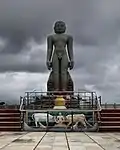Chandraprabha
Chandraprabha (English: Lord of Moon[1]) or Chandranatha is the eighth Tirthankara of Tīrthaṅkara of Jainism in the present age (Avasarpini). According to traditional accounts, he was born to King Mahasena and Queen Lakshmana Devi at Chandrapuri to the Ikshvaku dynasty. According to Jain texts, his birth-date was the twelfth day of the Posh Krishna month of the Indian calendar. He is said to have become a siddha, a liberated soul which has destroyed all of its karma.
| Chandraprabha | |
|---|---|
8th Jain Tirthankara | |
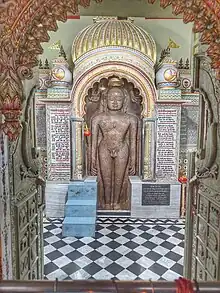 Chandraprabha statue, Sonagiri | |
| Other names | Chanda Prabhu |
| Venerated in | Jainism |
| Predecessor | Suparshvanatha |
| Successor | Pushpadanta |
| Symbol | Crescent Moon |
| Height | 150 bows (450 meters) |
| Age | 1,000,000 purva (70.56 Quintillion years) |
| Color | White |
| Personal information | |
| Born | |
| Died | |
| Parents |
|
| Part of a series on |
| Jainism |
|---|
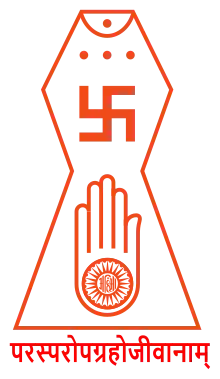 |
Jain biography
Birth
Chandraprabha was the eighth Jain Tīrthankara of the present age (avasarpini).[2] He was born to King Mahasena and Queen Lakshmana Devi at Chandrapuri,[3] Varanasi on 12th day month Pausa in the Ikshvaku clan.[4][2][5][6] Nine months before the birth of Chandraprabha, Queen Lakshmana Devi dreamt the sixteen most auspicious dreams.[7] Mahasena named Tirthankar Chandraprabha because of his complexion was white as moon. According to Uttarapurana, Indra named him Chandraprabha because at his birth the earth and night-lotus were blossomed.[5]
Life before renunciation
Chandraprabha spent 2 lakh pūrva as youth (kumāra kāla) and ruled His kingdom for 6 lakh pūrva and 24 pūrvāṇga (rājya kāla). During his rule, Chandraprabhu was apathetic towards the ordinary delights and princely grandeur.[8]
Renunciation
He decided to renounced his worldly life, soon after his ascension to throne and after 3 months he obtained Kevala Jnana (omniscience) while mediating under Naga tree.[5]
Nirvana and moksha
After a many years of spreading his knowledge, he is said to have attained nirvana at Sammed Shikharji on the seventh day of the bright half of the month of faalgun.[7][note 1]
The yaksha and yakshi of Shantinatha are Śyāma and Jvālāmālinī according to Digambara tradition and Vijaya and Bhṛkuṭi according to Śvētāmbara tradition.[5]
Legacy
Worship
Jinastotrāņi is a collection of hymn dedicated to Chandraprabha along with Munisuvrata, Neminatha, Shantinatha, Mahavira, Parshvanatha and Rishabhanatha.[11]
Svayambhūstotra by Acharya Samantabhadra is the adoration of twenty-four Tīrthankaras. Its five slokas (aphorisms) are dedicated to Tīrthankara Chandraprabha.[12]
With complexation bright as the rays of the moon you had the radiated knowledge like another moon. You are worshiped by eminent beings; you are the Lord of learned ascetic; and had conquered all your karmas and internal passion. I bow to you, O Lord Chandraprabha, the processor of moonlike splendour.
— Svayambhūstotra (8-1-36)[13]
Chandraprabha is associated with crescent moon emblem, Naga tree, Vijya or Śyāma (Dig.) & Vijya (Svet.) Yaksha and Jwalamalini (Dig.) & Bhṛkuṭi (Svet.) Yakshi.[14][5][15]
In literature
Chandraprabha-charitra composed by Haribhadra is an adoration to Chandraprabha.[16] Chandraprabha is mentioned in the Buddhist scriptures.[17]
Iconography
Chandraprabha is usually depicted in a lotus or kayotsarga posture, with a crescent moon symbol beneath him;[5] each tīrthankara has a distinct emblem, which allows worshippers to distinguish similar idols.[18] Like all tirthankaras, he is depicted with a Shrivatsa[note 2] and downcast eyes.[21]
The earliest known sculpture of Chandraprabha was installed by Maharajadhiraja Ramagupta of Gupta dynasty in 4th century CE. Chandraprabha has been popular amongst Jain everywhere in India. The iconography of Chandraprabha is particularly popular in Eastern India in Bihar, Bengal and Orissa. Sculptures of Chandraprabha were also popular in Jain temples, Deogarh, Khajuraho Jain temples and Sonagiri.[22]
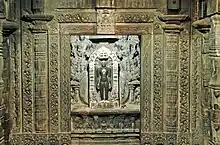 Idol at Jain temple, Lakkundi
Idol at Jain temple, Lakkundi Idol at Saavira Kambada Basadi
Idol at Saavira Kambada Basadi_(cropped).jpg.webp) The famous idol of Chandraprabhu at Tijara
The famous idol of Chandraprabhu at Tijara Chandraprabha temple inside Jaisalmer Fort
Chandraprabha temple inside Jaisalmer Fort
Colossal statue
Guru mandir in Mandaragiri houses a 21 feet (6.4 m) monolithic statue of Chandraprabha.[23][24]
Main temples
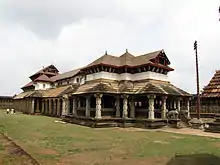
Various Jain temple complexes across India feature him, and these are important pilgrimage sites in Jainism. Sonagiri, also known as Laghu Sammed Shikhar is a Siddha-Kṣetra,[25][26] is considered one of the most important Jain Tirtha (pilgrimage site).[27] The mulnayak is a 3 metres (9.8 ft) rock cut image of Chandraprabhu dating back to the 5th to 6th century.[28] There are a total of 103 temples with 77 on hill and 26 in village.[29][30]
Saavira Kambada Basadi (Thousand Pillared Temple ) in Moodabidri (Jain Kashi[31]), built in 1430 CE, is considered an architectural wonder and is one of the most important Jain centers in Karnataka.[32][33][34] Vijayamangalam Jain temple was built in c. 678 C.E. by King Konguvelir of Velir dynasty.[35][36]
Important Chandraprabha temple complexes include: Tijara Jain temple, Jainimedu Jain temple, Chandravati, Kumbakonam Jain Temple, Mandaragiri, Prabhas Patan, Lunwa Jain temple, Chandranatha basadi Dharmasthala, and Chandraprabha temple, Pavagadh
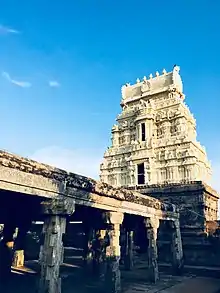 Vijayamangalam Jain temple built in 678 C.E.
Vijayamangalam Jain temple built in 678 C.E.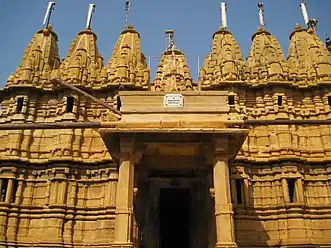
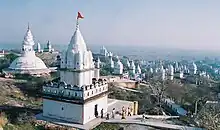
.jpg.webp)
See also
Notes
- Some texts refer to the place as Mount Sammeta.[9] This place is revered in Jainism because 20 out of 24 Jinas died here.[10]
- A special symbol that marks the chest of a Tirthankara. The yoga pose is very common in Buddhism, Hinduism, and Jainism. Each tradition has had a distinctive auspicious chest mark that allows devotees to identify a meditating statue to symbolic icon for their theology. There are several srivasta found in ancient and medieval Jain art works, and these are not found on Buddhist or Hindu art works.[19][20]
References
Citation
- Coulter & Turner 2013, p. 277.
- Tukol 1980, p. 31.
- Singh 2009, p. 35.
- von Glasenapp 1925, pp. 300–301.
- Shah 1987, p. 142.
- Singh, Binay (25 August 2015). "4 Jain Tirthankaras born in Varanasi | Varanasi News – Times of India". The Times of India. Retrieved 3 September 2022.
- Jain 2015, p. 189.
- Jain 2015, p. 190.
- Jacobi 1964, p. 275.
- Cort 2010, pp. 130–133.
- Lienhard 1984, p. 137.
- Jain 2015, p. 44-50.
- Jain 2015, p. 52.
- Titze & Bruhn 1998, p. 5.
- Tandon 2002.
- Agnihotri 2010, p. 34.
- Sangave 2006, p. 21.
- Zimmer 1953, p. 225.
- von Glasenapp 1925, pp. 426–428.
- Jainism: Jinas and Other Deities Archived 26 May 2017 at the Wayback Machine, Victoria and Albert Museum, London
- Melton & Baumann 2010, p. 1553.
- Shah 1987, pp. 142–145.
- Krishnaraja 2021.
- Binayak 2020.
- Detige 2017, p. 38.
- Shukla & Kulshreshtha 2019, p. 103.
- Burgess & Cousens 1903, p. 21.
- Titze & Bruhn 1998, p. 128.
- Mitra 2009, p. 75.
- Mitra 2012, p. 52.
- Titze & Bruhn 1998, p. 47.
- Paul 2019, p. 18.
- Butalia & Small 2004, p. 367.
- Panikar 2010, p. 408.
- Home Ministry 2011, p. 110.
- Krishnamachari 2017.
Books
- Agnihotri, V. K. (2010) [1981]. Indian History (26 ed.). Allied Publishers. ISBN 978-81-8424-568-4.
- Butalia, Tarunjit Singh; Small, Dianne P. (2004). Religion in Ohio: Profiles of Faith Communities. Ohio University Press. ISBN 978-0-8214-1551-1.
- Burgess, James; Cousens, Henry (1903). The Architectural Antiquities of Northern Gujarat, More Especially of the Districts Included in the Baroda State. Archaeological survey of western India. Vol. 9. Bombay: B. Quaritch.
- Cort, John E. (2010), Framing the Jina: Narratives of Icons and Idols in Jain History, Oxford University Press, ISBN 978-0-19-538502-1
- Coulter, Charles Russell; Turner, Patricia (2013). Encyclopedia of Ancient Deities. Routledge. ISBN 9781135963972.
- Jacobi, Hermann (1964), Max Muller (ed.), Jain Sūtras (Translation), The Sacred Books of the East Series, vol. XXII, Motilal Banarsidass (Original: Oxford University Press)
- Jain, Vijay K. (2015). Acarya Samantabhadra's Svayambhustotra: Adoration of The Twenty-four Tirthankara. Vikalp Printers. ISBN 9788190363976.
- Johnson, Helen M. (1931). Candraprabhacaritra (Book 3.6 of the Trishashti Shalaka Purusha Caritra). Baroda Oriental Institute.
- Lienhard, Siegfried (1984), A History of Classical Poetry: Sanskrit, Pali, Prakrit, A history of Indian literature: Classical Sanskrit literature, vol. 1, Harrassowitz Verlag, ISBN 978-1-84511-625-5
- Mitra, Swati (2009). Orchha, Travel Guide. Goodearth Publications. ISBN 9788187780915.
- Mitra, Swati (2012). Temples of Madhya Pradesh (1 ed.). Goodearth Publications. ISBN 9789380262499.
- Melton, J. Gordon; Baumann, Martin, eds. (2010). Religions of the World: A Comprehensive Encyclopedia of Beliefs and Practices. Vol. One: A-B (Second ed.). ABC-CLIO. ISBN 978-1-59884-204-3.
- Panikar, Agustin (2010). Jainism: History, Society, Philosophy and Practice. Lala Sunder Lal Jain research series. Vol. 24. Delhi: Motilal Banarsidass. ISBN 978-81-208-3460-6.
- Paul, George S. (2019). Vasundhara - Odyssey of a Dancer. Chennai: Notion Press. ISBN 978-1-64587-531-4.
- Sangave, Vilas Adinath (2006) [1990]. Aspects of Jaina religion (5 ed.). Bharatiya Jnanpith. ISBN 978-81-263-1273-3.
- Shah, Umakant Premanand (1987). Jaina-rūpa-maṇḍana: Jaina iconography. Abhinav Publications. ISBN 978-81-7017-208-6.
- Shukla, U. N.; Kulshreshtha, Sharad Kumar (2019), Emerging Trends in Indian Tourism and Hospitality: Transformation and Innovation, Copal Publishing Group, ISBN 9789383419760
- Singh, Rana (2009). Banaras: Making of India's Heritage City. Planet Earth & Cultural Understanding. Cambridge Scholars Publishing. ISBN 9781443815796.
- Tandon, Om Prakash (2002) [1968]. Jaina Shrines in India (1 ed.). New Delhi: Publications Division, Ministry of Information and Broadcasting, Government of India. ISBN 81-230-1013-3.
- Titze, Kurt; Bruhn, Klaus (1998). Jainism: A Pictorial Guide to the Religion of Non-Violence (2 ed.). Motilal Banarsidass. ISBN 81-208-1534-3.
- Tukol, T. K. (1980). Compendium of Jainism. Dharwad: University of Karnataka.
- von Glasenapp, Helmuth (1925). Jainism: An Indian Religion of Salvation. Delhi: Motilal Banarsidass (Reprinted 1999). ISBN 978-81-208-1376-2.
- Zimmer, Heinrich (1953) [April 1952]. Campbell, Joseph (ed.). Philosophies Of India. London: Routledge & Kegan Paul Ltd. ISBN 978-81-208-0739-6.
Web
- Detige, Tillo (2017). "Manuscript Collections of the Western and Central Indian Bhaṭṭārakas". SOAS University of London (12): 36–39. Retrieved 21 September 2022.
- Krishnamachari, Suganthy (12 October 2017). "On how Kongu Nadu was a Jain bastion". The Hindu. ISSN 0971-751X. Retrieved 25 January 2021.
- Krishnaraja, Renuka (31 March 2021). "The serene hills of Mandaragiri". Deccan Herald. Retrieved 10 December 2022.
- Home Ministry (2011). "District census handbook Erode" (PDF). Census. Retrieved 7 April 2022.
- Binayak, Pooja (19 August 2020). "India's Jain Temples Are Incredible Architectural Marvels". Fodor's. Retrieved 10 December 2022.
